

Compact Muon Solenoid
LHC, CERN
| CMS-PAS-FTR-18-024 | ||
| Open heavy flavor and quarkonia in heavy ion collisions at HL-LHC | ||
| CMS Collaboration | ||
| December 2018 | ||
| Abstract: The projected performance for heavy flavour hadrons and quarkonium measurements in the high luminosity phase of the LHC in pp and PbPb collisions at √sNN= 5.02 TeV is presented, focusing on J/ψ and Υ(nS) states (including the elliptic flow v2), as well as Bs mesons and Λ+c baryons. Projections for the nuclear modification factor of B+, B0 and Bs mesons in pPb data at √sNN= 5.02 TeV are also reported. | ||
| Links: CDS record (PDF) ; inSPIRE record ; CADI line (restricted) ; | ||
| Figures | |
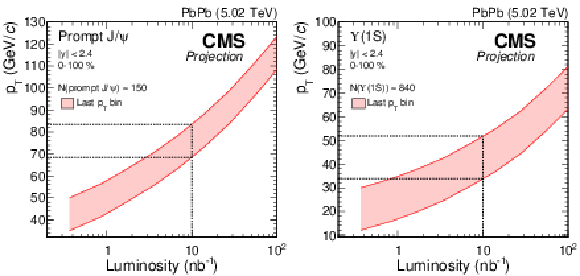
png pdf |
Figure 1:
Prompt J/ψ and Υ(1S) [pTlow,pTup] boundaries as a function of luminosity. The boundaries are chosen in such a way the number of mesons in the bin for the corresponding luminosity equals the number of mesons found in the last pT bin of the analysis with a luminosity of 368 μb−1. |

png pdf |
Figure 1-a:
Prompt J/ψ [pTlow,pTup] boundaries as a function of luminosity. The boundaries are chosen in such a way the number of mesons in the bin for the corresponding luminosity equals the number of mesons found in the last pT bin of the analysis with a luminosity of 368 μb−1. |
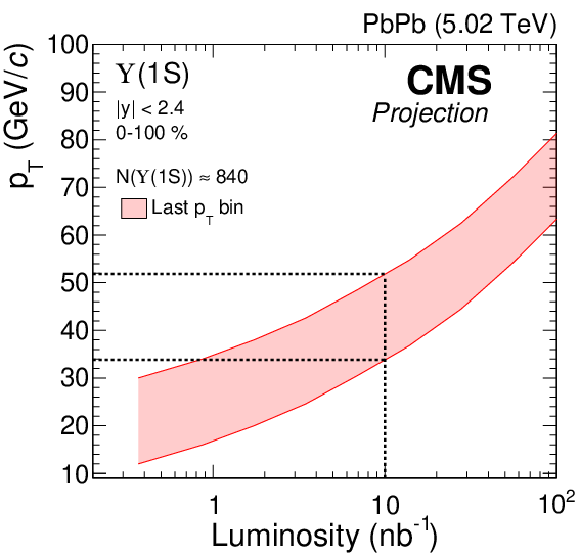
png pdf |
Figure 1-b:
Υ(1S) [pTlow,pTup] boundaries as a function of luminosity. The boundaries are chosen in such a way the number of mesons in the bin for the corresponding luminosity equals the number of mesons found in the last pT bin of the analysis with a luminosity of 368 μb−1. |
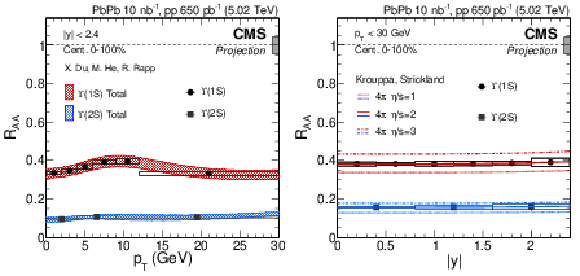
png pdf |
Figure 2:
Projections of RAA of Υ(1S) and Υ(2S) as a function of pT (left) and y (right), assuming 10 nb−1, and reduction of the total systematic uncertainty by 1/3. Central values are taken from Ref. [25] for the pT dependence and Ref. [26] for the y dependence. |
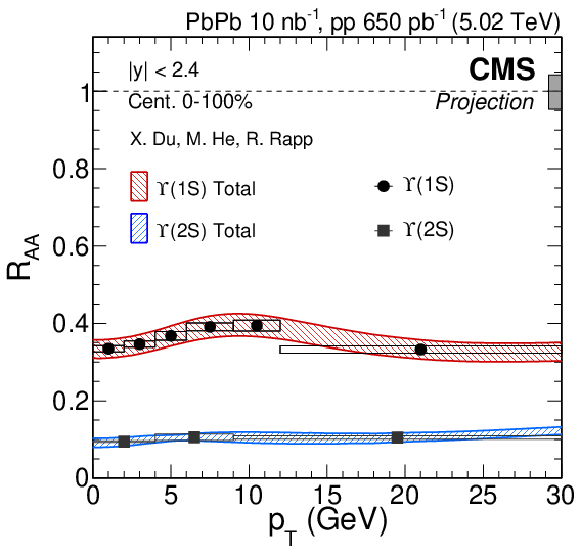
png pdf |
Figure 2-a:
Projections of RAA of Υ(1S) and Υ(2S) as a function of pT, assuming 10 nb−1, and reduction of the total systematic uncertainty by 1/3. Central values are taken from Ref. [25]. |
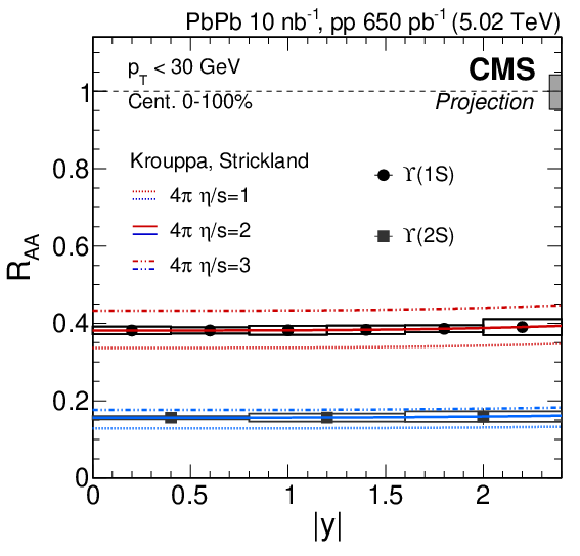
png pdf |
Figure 2-b:
Projections of RAA of Υ(1S) and Υ(2S) as a function of y, assuming 10 nb−1, and reduction of the total systematic uncertainty by 1/3. Central values are taken from Ref. [26]. |

png pdf |
Figure 3:
Projections for Υ(1S) (left) and Υ(2S) (right) v2, assuming 10 nb−1. The projected data points are overlaid with the total theoretical prediction [25], where the primordial (green) and regenerated (blue) components are also shown separately. |
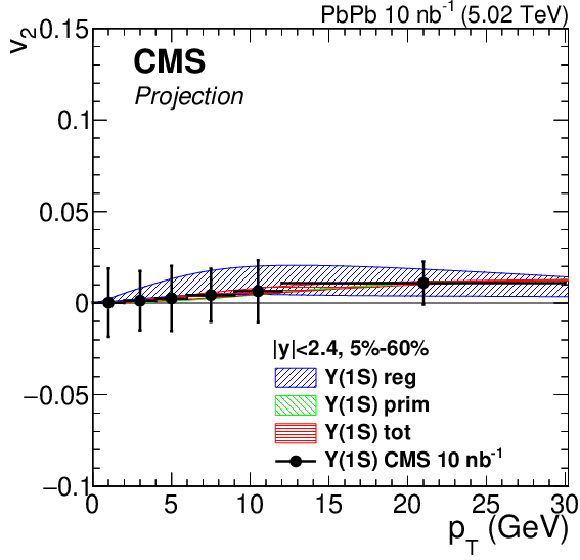
png pdf |
Figure 3-a:
Projections for Υ(1S) v2, assuming 10 nb−1. The projected data points are overlaid with the total theoretical prediction [25], where the primordial (green) and regenerated (blue) components are also shown separately. |
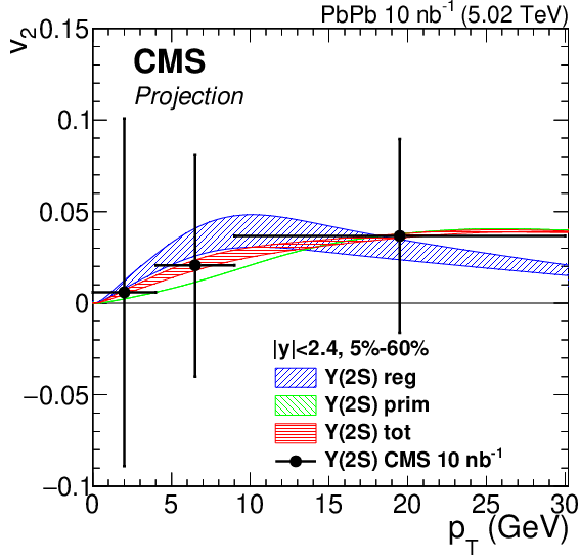
png pdf |
Figure 3-b:
Projections for Υ(2S) v2, assuming 10 nb−1. The projected data points are overlaid with the total theoretical prediction [25], where the primordial (green) and regenerated (blue) components are also shown separately. |

png pdf |
Figure 4:
Current uncertainties on the RAA of Bs in 2015 PbPb collisions [12] (left) and projection using 10 nb−1 of PbPb data at √sNN= 5.02 TeV (right). The central values are taken from the TAMU model [32,33]. The B+ and nonprompt J/ψ uncertainties from current measurements [34,11] and their projection in 10 nb−1 of PbPb data [1] are also shown. |

png pdf |
Figure 5:
Expected pK+π− invariant mass spectrum in pp (4 <pT< 5 GeV/c, left) and PbPb (10 <pT< 20 GeV/c, centrality range 0-30%, right) collisions. The red line represents the signal on top of the background and the blue line represents the background. The signal fit function is double Gaussian and the background fit function is the 2nd-order Chebychev polynomial function. |

png pdf |
Figure 5-a:
Expected pK+π− invariant mass spectrum in pp (4 <pT< 5 GeV/c) PbPb collisions. The red line represents the signal on top of the background and the blue line represents the background. The signal fit function is double Gaussian and the background fit function is the 2nd-order Chebychev polynomial function. |

png pdf |
Figure 5-b:
Expected pK+π− invariant mass spectrum in PbPb (10 <pT< 20 GeV/c, centrality range 0-30%) collisions. The red line represents the signal on top of the background and the blue line represents the background. The signal fit function is double Gaussian and the background fit function is the 2nd-order Chebychev polynomial function. |
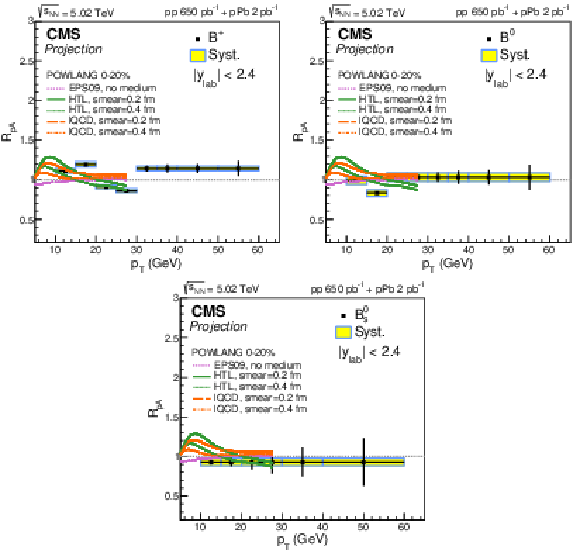
png pdf |
Figure 6:
Projection of nuclear modification factors of B+ (top left), B0 (top right) and Bs (bottom) in pPb collisions with 2 pb−1 of pPb data. Predictions from POWLANG [41] model under different transport coefficients and the smearing of the initial condition. |

png pdf |
Figure 6-a:
Projection of nuclear modification factors of B+ in pPb collisions with 2 pb−1 of pPb data. Predictions from POWLANG [41] model under different transport coefficients and the smearing of the initial condition. |
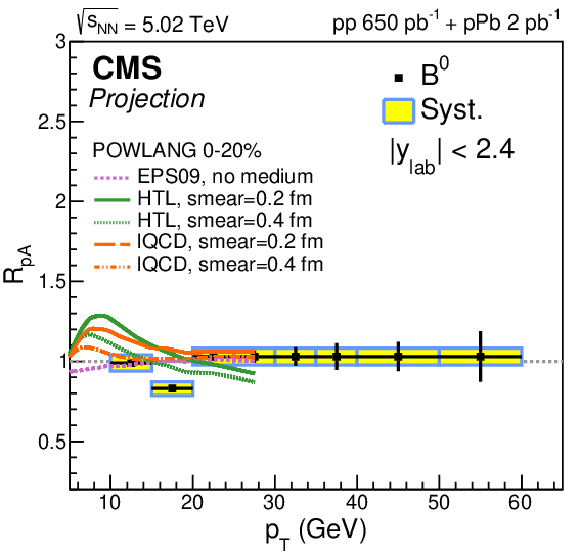
png pdf |
Figure 6-b:
Projection of nuclear modification factors of B0 in pPb collisions with 2 pb−1 of pPb data. Predictions from POWLANG [41] model under different transport coefficients and the smearing of the initial condition. |
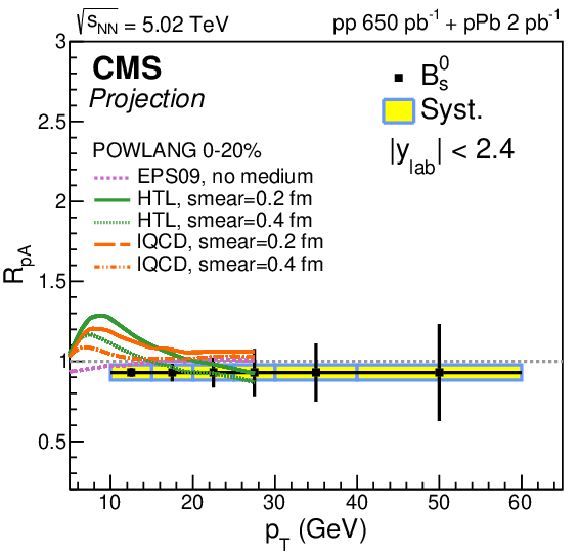
png pdf |
Figure 6-c:
Projection of nuclear modification factors of Bs in pPb collisions with 2 pb−1 of pPb data. Predictions from POWLANG [41] model under different transport coefficients and the smearing of the initial condition. |
| Summary |
| Very precise and differential measurements of quarkonia and heavy flavour mesons will be made possible at the HL-LHC, benefiting from the very large data sample (10 nb−1), combined with the excellent performance of the CMS detector in terms of pseudo-rapidity coverage, vertex reconstruction, muon tracking (identification and momentum resolution), and charged particle tracking. Quarkonia will be measured up to very high pT, allowing for direct comparison to charged particles, and D0 and B mesons, providing crucial information on parton energy loss. The precise measurement of Υ(nS)RAA as a function of pT and |y| will allow to better understand the ingredients to bottomonium suppression in PbPb collisions, in complement to the first Υ(nS) v2 measurements in PbPb. Despite their limited precision, v2 measurements will provide crucial inputs to models and be sensitive to a possible large signal, not unexpected given existing measurements of J/ψ v2 in pPb and PbPb. Bs meson production in pp and PbPb collisions will also be measured with sufficient precision to be compared to B+ meson suppression and investigate strangeness enhancement due to recombination with strange quarks. Λc baryon production will also be measured in pp and PbPb collisions, providing an additional handle for the study of charm quark dynamics in the medium, as well as the charm quark hadronisation to Λc baryons. Finally, precise measurements of B+, B0 and Bs\ mesons in pPb collisions will provide a baseline for the study of in-medium b quark energy loss in PbPb collisions. |
| References | ||||
| 1 | CMS Collaboration | Projected Heavy Ion Physics Performance at the High Luminosity LHC Era with the CMS Detector | CMS-PAS-FTR-17-002 | CMS-PAS-FTR-17-002 |
| 2 | CMS Collaboration | The CMS Experiment at the CERN LHC | JINST 3 (2008) S08004 | CMS-00-001 |
| 3 | G. Apollinari et al. | High-Luminosity Large Hadron Collider (HL-LHC) : Preliminary Design Report | ||
| 4 | CMS Collaboration | Technical Proposal for the Phase-II Upgrade of the CMS Detector | CMS-PAS-TDR-15-002 | CMS-PAS-TDR-15-002 |
| 5 | CMS Collaboration | The Phase-2 Upgrade of the CMS Tracker | CDS | |
| 6 | CMS Collaboration | The Phase-2 Upgrade of the CMS Barrel Calorimeters Technical Design Report | CDS | |
| 7 | CMS Collaboration | The Phase-2 Upgrade of the CMS Endcap Calorimeter | CDS | |
| 8 | CMS Collaboration | The Phase-2 Upgrade of the CMS Muon Detectors | CDS | |
| 9 | CMS Collaboration | CMS Phase-2 Object Performance | technical report, in preparation | |
| 10 | CMS Collaboration | Measurement of nuclear modification factors of Υ(1S), Υ(2S), and Υ(3S) mesons in PbPb collisions at √sNN= 5.02 TeV | CMS-HIN-16-023 1805.09215 |
|
| 11 | CMS Collaboration | Measurement of prompt and nonprompt charmonium suppression in PbPb collisions at 5.02 TeV | EPJC 78 (2018) 509 | CMS-HIN-16-025 1712.08959 |
| 12 | CMS Collaboration | Measurement of the B0s meson nuclear modification factor in PbPb collisions at √sNN=5.02TeV | CMS-PAS-HIN-17-008 | CMS-PAS-HIN-17-008 |
| 13 | CMS Collaboration | Performance study of λbda±C reconstruction in pp and PbPb collisions at √sNN= 5.02 TeV | CDS | |
| 14 | CMS Collaboration | Study of B Meson Production in p+Pb Collisions at √sNN= 5.02 TeV Using Exclusive Hadronic Decays | PRL 116 (2016) 032301 | CMS-HIN-14-004 1508.06678 |
| 15 | ATLAS Collaboration | Prompt and non-prompt J/ψ and ψ(2S) suppression at high transverse momentum in 5.02TeV Pb+Pb collisions with the ATLAS experiment | EPJC 78 (2018) 762 | 1805.04077 |
| 16 | CMS Collaboration | Nuclear modification factor of D0 mesons in PbPb collisions at √sNN= 5.02 TeV | PLB 782 (2018) 474 | CMS-HIN-16-001 1708.04962 |
| 17 | CMS Collaboration | Charged-particle nuclear modification factors in PbPb and pPb collisions at √sNN= 5.02 TeV | JHEP 04 (2017) 039 | CMS-HIN-15-015 1611.01664 |
| 18 | M. Spousta | On similarity of jet quenching and charmonia suppression | PLB767 (2017) 10 | 1606.00903 |
| 19 | F. Arleo | Quenching of Hadron Spectra in Heavy Ion Collisions at the LHC | PRL 119 (2017) 062302 | 1703.10852 |
| 20 | M. Strickland | Thermal Υ(1S) and chib1 suppression in √sNN= 2.76 TeV Pb-Pb collisions at the LHC | PRL 107 (2011) 132301 | 1106.2571 |
| 21 | X. Du and R. Rapp | Sequential Regeneration of Charmonia in Heavy-Ion Collisions | NP A 943 (2015) 147 | 1504.00670 |
| 22 | R. L. Thews, M. Schroedter, and J. Rafelski | Enhanced J/ψ production in deconfined quark matter | PRC 63 (2001) 054905 | hep-ph/0007323 |
| 23 | M. I. Gorenstein, A. P. Kostyuk, H. Stoecker, and W. Greiner | Statistical coalescence model with exact charm conservation | PLB 509 (2001) 277 | hep-ph/0010148 |
| 24 | A. Andronic, P. Braun-Munzinger, K. Redlich, and J. Stachel | Evidence for charmonium generation at the phase boundary in ultra-relativistic nuclear collisions | PLB 652 (2007) 259 | nucl-th/0701079 |
| 25 | X. Du, R. Rapp, and M. He | Color Screening and Regeneration of Bottomonia in High-Energy Heavy-Ion Collisions | PRC 96 (2017), no. 5, 054901 | 1706.08670 |
| 26 | B. Krouppa, A. Rothkopf, and M. Strickland | Bottomonium suppression using a lattice QCD vetted potential | PRD 97 (2018) 016017 | 1710.02319 |
| 27 | CMS Collaboration | Suppression and azimuthal anisotropy of prompt and nonprompt J/ψ production in PbPb collisions at √sNN= 2.76 TeV | EPJC 77 (2017), no. 4, 252 | CMS-HIN-14-005 1610.00613 |
| 28 | ALICE Collaboration | J/ψ elliptic flow in Pb-Pb collisions at √sNN= 5.02 TeV | PRL 119 (2017) 242301 | 1709.05260 |
| 29 | ATLAS Collaboration | Prompt and non-prompt J/ψ elliptic flow in Pb+Pb collisions at √sNN= 5.02 Tev with the ATLAS detector | EPJC 78 (2018) 784 | 1807.05198 |
| 30 | CMS Collaboration | Observation of prompt J/ψ meson elliptic flow in high-multiplicity pPb collisions at √sNN= 8.16 TeV | Submitted to: PL(2018) | CMS-HIN-18-010 1810.01473 |
| 31 | J. Rafelski and B. Muller | Strangeness production in the quark-gluon plasma | PRL 48 (1982) 1066 | |
| 32 | M. He, R. J. Fries, and R. Rapp | Heavy-quark diffusion and hadronization in quark-gluon plasma | PRC 86 (2012) 014903 | 1106.6006 |
| 33 | M. He, R. J. Fries, and R. Rapp | Heavy flavor at the large hadron collider in a strong coupling approach | PLB 735 (2014) 445 | 1401.3817 |
| 34 | CMS Collaboration | Measurement of the B± Meson Nuclear Modification Factor in Pb-Pb Collisions at √sNN=5.02TeV | PRL 119 (2017) 152301 | CMS-HIN-16-011 1705.04727 |
| 35 | M. Cacciari, M. Greco, and P. Nason | The pT spectrum in heavy-flavour hadroproduction | JHEP 05 (1998) 007 | hep-ph/9803400 |
| 36 | M. Cacciari and P. Nason | Charm cross sections for the Tevatron Run II | JHEP 09 (2003) 006 | hep-ph/0306212 |
| 37 | M. Cacciari et al. | Theoretical predictions for charm and bottom production at the LHC | JHEP 10 (2012) 137 | 1205.6344 |
| 38 | K. J. Eskola, H. Paukkunen, and C. A. Salgado | EPS09: A New Generation of NLO and LO Nuclear Parton Distribution Functions | JHEP 04 (2009) 065 | 0902.4154 |
| 39 | D. de Florian and R. Sassot | Nuclear parton distributions at next to leading order | PRD 69 (2004) 074028 | |
| 40 | L. Frankfurt, V. Guzey, and M. Strikman | Leading twist nuclear shadowing phenomena in hard processes with nuclei | Physics Reports 512 (2012) 255, . Leading twist nuclear shadowing phenomena in hard processes with nuclei | |
| 41 | A. Beraudo et al. | Heavy-flavour production in high-energy d-Au and p-Pb collisions | JHEP 03 (2016) 123 | 1512.05186 |

|
Compact Muon Solenoid LHC, CERN |

|

|

|

|

|

|